
[ad_1]
When 38-year-old Shakir Khan watched the character of Ali Abdul, a factory worker from Pakistan in the South Korean survival drama ‘Squid Game’, it was like he was watching his own story play out in front of his eyes.
“I felt like it was my story. It is just like what you see in the drama.” Seven years ago, Khan left his wife and children in Lahore, hoping that employment in South Korea would allow him to give his family a better life. But when he first landed in Seoul, he was unaware of the bleak future that awaited.
After it was first released on September 17, Netflix claims Squid Game reached the number one spot in 90 countries, including India, in just one month and has become the biggest show that the streaming service has ever produced. Played by Indian national Anupam Tripathi, an actor based in Seoul who has had minor roles in some Korean dramas, for many viewers, Ali and his tragic story have come across as a conspicuous discovery.
“I want to make money,” Ali tells a fellow player. Dependent on him are his wife and newborn child. An undocumented worker from Pakistan, with a harsh employer who withholds his salary for several months, Ali’s difficulties are compounded when he loses a few of his fingers while working at the factory.
Just a quick note to say Ali from Squid Game deserves the world. pic.twitter.com/6FSbSgIVH4
— Netflix UK & Ireland (@NetflixUK) September 30, 2021
It isn’t as much Ali’s nationality as it is his circumstances that resonate with Khan. Rather, it is the lived experiences of the thousands of men and women from South Asia and Southeast Asia who work across farms and factories in South Korea. For migrant workers like Khan, illness, injury and death are a part of everyday life in the country.
A few months ago, one of Khan’s acquaintances from India injured his hand during a workplace accident and ended up losing four fingers, much like Ali in the drama. “He didn’t even get any compensation. He came to work here but suffered so much,” said Khan. Still, Khan said the man was one of the more fortunate migrant workers in South Korea.
 Most migrant workers in South Korea live on site, and are provided accommodation inside shipping containers that have been partially modified and turned into shelters. Photo credit: Virendra Verma
Most migrant workers in South Korea live on site, and are provided accommodation inside shipping containers that have been partially modified and turned into shelters. Photo credit: Virendra Verma
This past winter, Khan woke up one morning to hear that a friend working in a local factory in Gyeonggi province had died because of the extreme cold. Most migrant workers in the country live on site, and are provided accommodation inside shipping containers that have been partially modified and turned into shelters. Living inside these spaces that have few provisions for heating, can be difficult during South Korea’s four-month long brutal winters.
“Last year, a woman from Vietnam died because of the cold inside her container. The employer found her body the next morning,” recalled Sanjay Yadav, who has been living and working in South Korea for two decades. For the Indian migrant worker community, all of whom are in the country without lawful paperwork, Yadav has been an indispensable resource and support.
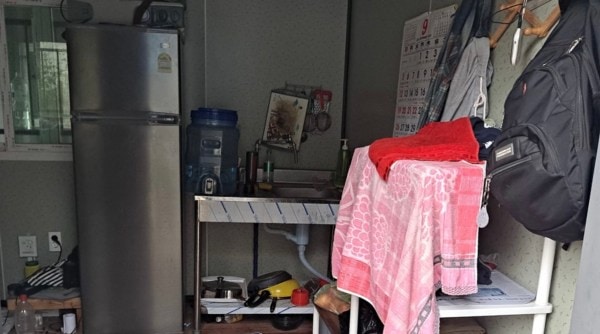 Most migrant workers in South Korea live on site, and are provided accommodation inside shipping containers that have been partially modified and turned into shelters. Photo credit: Virendra Verma
Most migrant workers in South Korea live on site, and are provided accommodation inside shipping containers that have been partially modified and turned into shelters. Photo credit: Virendra Verma
Although there are no official figures, Yadav believes that close to 70% of migrant workers in South Korea live in containers like these, that have been converted into one room spaces with a makeshift kitchenette and a bathroom.
In one scene in ‘Squid Game’, viewers are provided a brief glimpse of what life is like for migrant workers in these containers. But living inside one of these spaces year round is an incredibly challenging experience, something unfathomable for most people, and not fully captured in photographs and videos, Yadav said.
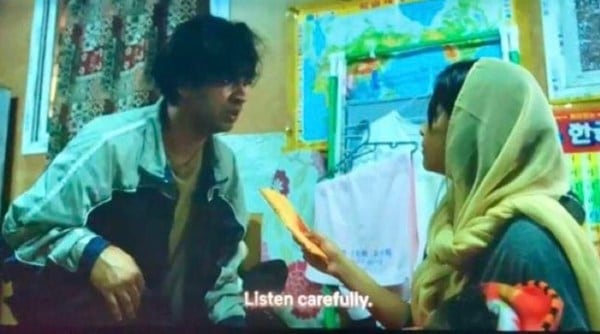 In one scene of ‘Squid Game’, Ali’s character is seen inside the shipping container where he lives. Photo credit: Screenshot
In one scene of ‘Squid Game’, Ali’s character is seen inside the shipping container where he lives. Photo credit: Screenshot
Among the migrant workers in the country, Verma said that illegal workers from India are worse off. In 2004, South Korea implemented its Employment Permit System to overcome labour shortages by allowing employers to legally hire an adequate number of foreign workers from a group of countries across Asia, including Nepal, Sri Lanka, Pakistan and Bangladesh. While citizens from these countries are legally permitted to work in South Korea for approximately five years and travel back and forth between their home countries, Seoul has no such agreements with New Delhi.
The Embassy of the Republic of Korea in India did not respond to indianexpress.com’s requests for statistics and comment at the time of publishing this report.
When Virendra Verma first arrived in South Korea 10 years ago, the country’s cold weather came with snow that reached his knees on the farm where he was sent to work. “I was unemployed in India and there were some agents who had told me that I would find work in South Korea. They said that after six months, I would get a work permit. They told me I would be able to travel back to India occasionally and that the work was good here,” Verma said.
Desperation forced Verma to take a loan of Rs. 4,00,000 (approx. US$ 5,000) to pay the agents and try his luck in a country that he had never visited and had known little about. “I have to support my family and educate my children. Now I am stuck here, so I have to do this.” Verma was duped into believing that he would be able to work in a small company that would allow him to send money back home and pay off his loans. When he arrived, he was sent to work on a farm, involving physical labour that he had never done before.
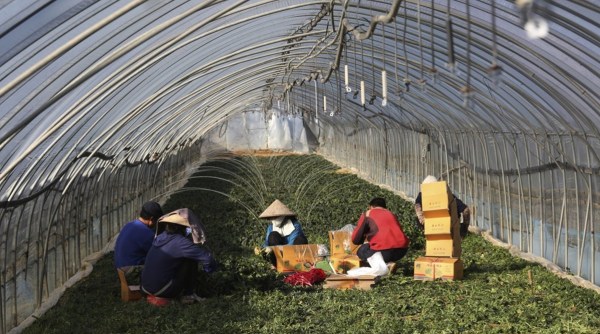 Migrant workers work inside a greenhouse at a farm in Pocheon, South Korea on Feb. 8, 2021. (AP Photo/Ahn Young-joon)
Migrant workers work inside a greenhouse at a farm in Pocheon, South Korea on Feb. 8, 2021. (AP Photo/Ahn Young-joon)
“When I came here, I found out that they were giving educated and uneducated people the same kind of physical, backbreaking work. The migrant workers are forced to do what is called 3D work—difficult, dangerous, dirty. Compulsion makes you do this kind of work. I’ve come here and now I’m stuck.”
The term 3-D comes from the Japanese expression ‘3Ks: kitanai, kiken, kitsui’; or ‘dirty’ ‘dangerous’ and ‘demanding’. The perception of these jobs has discouraged young South Koreans from taking them up, creating domestic labour shortages, because of which companies have turned to foreign workers who are willing to work, despite lower pay and poor work conditions.
According to a paper published in 2020 by Nigel Callinan, assistant professor at Hannam University, 10% of the total number of migrant workers in the country were found to be overstaying their visas in 2017. But there is little data on the number of Indian nationals who arrive in South Korea and end up working in farms and factories. Yadav believes that there are approximately 3,000 illegal Indian migrant workers presently living in the country.
The prospect of a salary of anything between US$1,300 and US$1,600 per month, an amount much below the legal minimum wage that these labour contracts ensure, is attractive enough to draw desperate Indians to travel to South Korea without appropriate visas, in many cases, with the knowledge that they are violating immigration laws, and will have to put up with difficult work conditions.
In the 10 years that Verma has lived here, he has missed his children growing up and his parents died waiting to see him in person. “If I go back, I won’t be able to return. When I talk to my wife and children over a video call, they sometimes cry.” But the thought of unemployment that he believes awaits him in India stops him from leaving his job at a factory that packages corn syrup.
Like Khan, Verma has seen so much suffering over the years in South Korea, that those stories make Ali’s in ‘Squid Game’ seem relatively less tragic. “A friend of mine from India was working in a livestock farm here. In an accident, a tractor driver drove over my friend’s leg. Then the driver got scared and was unable to stop the machine and my friend’s second leg got caught. When he tried to stop the machine with his hand, the machine swallowed his hand as well. He lost both legs and one arm.”
“He was in the hospital for five months. There has been no progress in the processing of his case, there has been no insurance payout, the driver has not paid damages and neither has any help from the government come in.” Their illegal status makes it difficult for the South Korean federal and local government to offer much assistance to such migrant workers, who are largely reliant on social workers and the kindness of people from their home country.
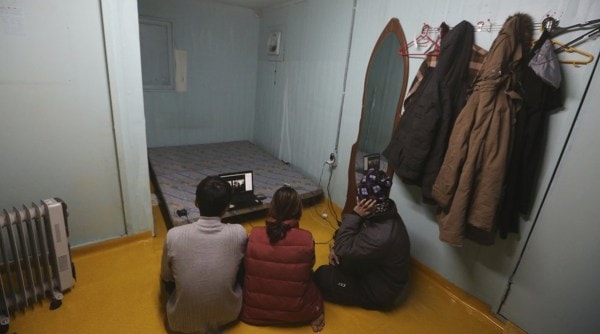 Cambodian workers speak during an online interview in a shipping container that is used as their home installed at a farm in Pocheon, South Korea on Feb. 8, 2021. (AP Photo/Ahn Young-joon)
Cambodian workers speak during an online interview in a shipping container that is used as their home installed at a farm in Pocheon, South Korea on Feb. 8, 2021. (AP Photo/Ahn Young-joon)
In addition to poor working and living conditions, migrant workers suffer from physical and mental health issues. For five to six days a week, many are compelled to work for 10 to 15 hours a day, with little rest.
“In the case of Indians, many factory owners threaten the workers with deportation, they withhold pay, and engage them in forced labour because they are illegal,” Yadav explained. Even among legal migrants, many do not possess valid paperwork once they leave abusive employers, resulting in immigration-related complications.
Unable to speak Korean, migrant workers who are new arrivals in the country face particularly difficult situations, left at the mercy of employers. “Some employers will promise three months salary together. Then three months later, they refuse to pay and throw the worker out. So the person is turned out onto the streets and has no place to go, no shelter, no money for food,” said Verma.
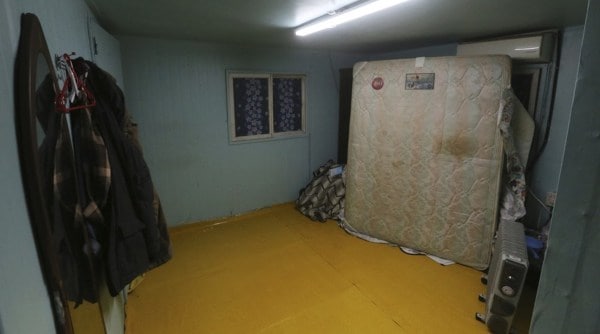 his photo shows clothes and a mattress of migrant workers in a shipping container, a makeshift home for them at a farm in Pocheon, South Korea on Feb. 8, 2021. (AP Photo/Ahn Young-joon)
his photo shows clothes and a mattress of migrant workers in a shipping container, a makeshift home for them at a farm in Pocheon, South Korea on Feb. 8, 2021. (AP Photo/Ahn Young-joon)
The desperation to provide a better life for their families compel them to send 90% of their meager salaries back home. Their illegal immigration status also means that employers exploit Indian workers by paying half of what is the regulation and is paid to workers from other countries in South Asia and Southeast Asia. “The basic salary comes to around Rs. 1,00,000 (approx. US$ 1,300), which is a lot for them. They send everything to their families,” said Yadav.
For years, there have been reports of workers being subjected to physical violence, exploitation and long hours of physical labour with no breaks, but there has been little change in the everyday lives of migrant workers in South Korea.
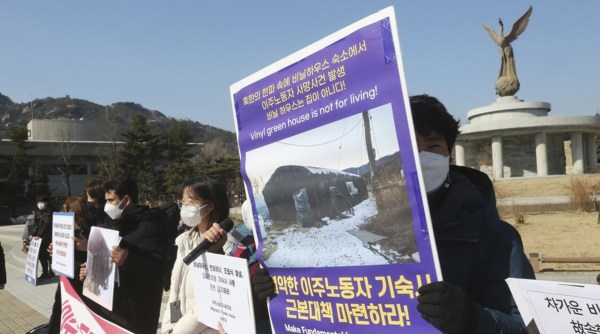 Human rights activists stage a rally calling for better living conditions for migrant workers near the presidential Blue House in Seoul, South Korea on Feb. 9, 2021. (AP Photo/Ahn Young-joon)
Human rights activists stage a rally calling for better living conditions for migrant workers near the presidential Blue House in Seoul, South Korea on Feb. 9, 2021. (AP Photo/Ahn Young-joon)
Ten days ago, a man who had arrived only three years ago in South Korea from Kolkata, began experiencing chest pain while sleeping alone in his container. By morning, he had died. When news of his death spread in the community, Yadav and some workers rushed to see what they could do. “The hospital asked for Rs. 6,00,000 (approx. US$ 7,900) for medical costs before releasing the body. If there is a tragedy, even the body can’t be sent back to India because it costs Rs. 4,00,000 – Rs. 5,00,000 (approx. US$ 5,000 – US$ 6,600). So we all contributed some money to conduct his funeral here. His family couldn’t even see him,” Verma said.
The man’s death gives Yadav nightmares that keep him awake at night and he hasn’t been able to sleep since the incident. “His family left his responsibility on me. We will immerse his ashes in the nearby river.”
“There are many who come to Korea and they remain here—their bodies remain here,” said Yadav.
[ad_2]
Source link